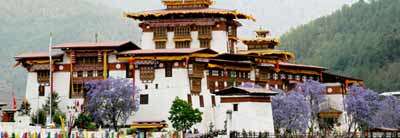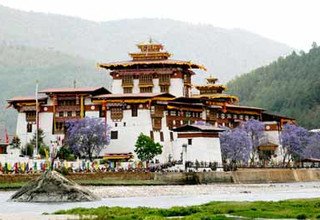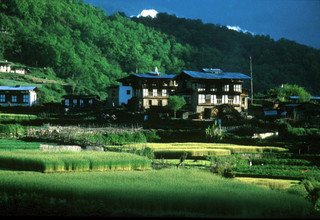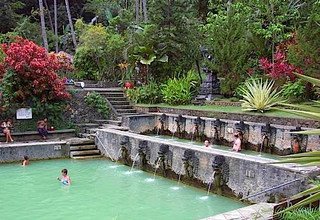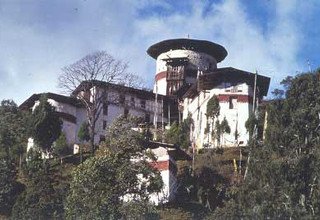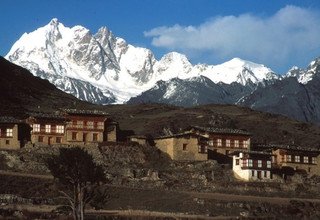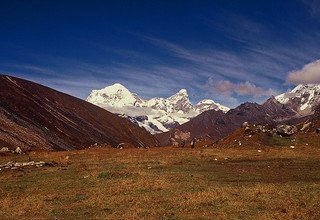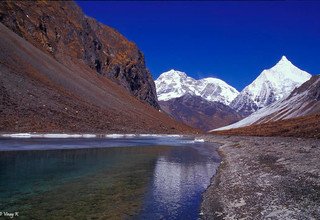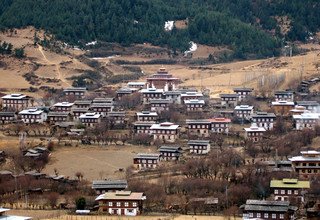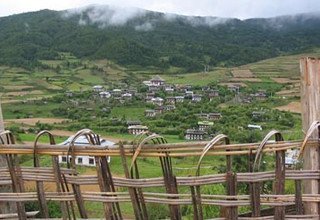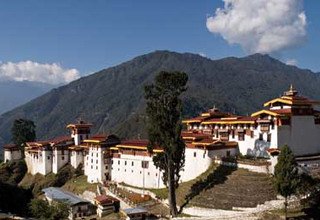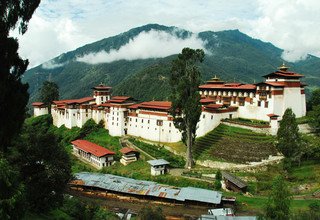Itinerary for Snowman Trek in Bhutan
Day 1: Arrive at Paro International Airport and transfer to hotel
Paro is situated in a beautiful valley at 2280 meters and is a fitting introduction to this charming kingdom. Your guide will meet you and take you to your hotel. There should be time for a quick stroll around Paro town before lunch. In the afternoon you can visit the impressive Paro Rinpung Dzong, one of the finest examples of Bhutanese architecture. You can also visit the National Museum. This was previously housed in the Ta Dzong (watch tower) built on top of the hill above Rinpung Dzong to defend Rinpung Dzong and the Paro valley during times of war, in an unusual circular construction resembling a conch shell. Unfortunately, an earthquake in September 2011 damaged the Ta Dzong and the contents of the museum were moved to a neighbouring building. You can still see a magnificent collection of Bhutanese artefacts — costumes, religious paintings, arms, textiles and a fascinating collection of Bhutan stamps. The National Museum is due to reopen in the Ta Dzong in 2015. Overnight at a 3-star hotel in Paro.
Day 2: Take a day hike to the ‘Tiger's Nest’
‘Tiger's Nest’, is the sacred Taktshang monastery which clings to the rock face 900 meters above the valley floor. Guru Rinpoche is said to have flown to the site riding on a tigress. He subsequently meditated here for three months. It is one of Bhutan’s most holy sites and draws pilgrims not only from Bhutan but also from neighboring Buddhist countries. You can have lunch at the Taktshang cafeteria from where you get a spectacular view of the monastery. In the afternoon you can also visit the 7th century Kyichu Lhakhang, a temple of historical significance and one of the most sacred shrines in Bhutan. Overnight at a 3* hotel in Paro.
Day 3: Paro to Shana 2870m/15km/5-6 hours (Snowman Trek - Day 1 Start)
Drive to the end of the motor road at Drukgyel Dzong to begin the trek. While you wait for the horses to load up you will have time to take a look at the ruined Dzong. Known as the fortress of victory, it was constructed to commemorate the victory over Tibetan invaders in 1644 and destroyed by a butter lamp fire in 1951. Today’s trail follows the river uphill through a narrow agricultural valley as far as the border army camp at about 2800m. There is now a feeder road as far as the army check post at Gunitsawa about half an hour before camp. Overnight at a tented camp.
Day 4: Shana to Soi Thangkha 3750m/20km/8-9 hours
The path from Shana ascends through the river valley with pine and rhododendron forests. On the way, there is a fantastic view of Mount Jomolhari. We will camp in a meadow with a stone shelter at an altitude of about 3750m. Overnight at a tented camp.
Day 5: Soi Thangkha to Jangothang 4040m/17km/5-6 hours
The trail continues to follow the river and passes a small army post where the valley begins to widen again. Views of high ridges and snow-capped peaks can be seen on all sides. At this altitude (about 4040m) it is possible to see yaks and yak herders. Camp is beneath a ruined fortress at the base of Mount Jomolhari. Overnight at a tented camp.
Day 6: Rest day at Jomolhari base camp
An opportunity to explore the glacier, do some washing in the stream (icy cold!) or just take it easy. If you feel like going further afield the guide will discuss the options with you. Overnight at a tented camp.
Day 7: Jangothang to Lingshi 4010m/18km/6-7 hours
The trail climbs gradually and then more steeply to Nyeli La (4850 m). On the way you will be rewarded when you stop for breath with tremendous views toward Jomolhari and Jitchu Drake. If the weather is clear, Lingshi Dzong can be clearly seen as we descend into the Lingshi basin, and Tserim Kang with its glaciers can be seen to the north. Follow the ridge for a long way until you drop through the forests to our camp just outside Lingshi village beside a stone shelter at 4010 metres. Overnight at a tented camp.
Day 8: Lingshi to Chebisa 3850m/12km/4-5 hours
Visit the Lingshi Dzong, perched on the hilltop with a commanding view of green hills, the winding river and magnificent peaks. For centuries, Lingzhi Dzong was a way station for weary Buddhist pilgrims and defense fort against Tibetan and Mongol invaders. It is an easy day and pleasant walk through villages and yak herders camp. After lunch, a short walk will take you to Chebisa, a charming little village adorned with a beautiful crystal clear waterfall. Camp by the side of stream at an altitude of 3850m. Overnight at a tented camp.
Day 9: Chebisa to Shoumuthang 4250m/17km/6-7 hours
Begin your trek with a stiff climb up a ridge to Gogu La pass (4500m) taking nearly four hours. The sights of rare blue sheep is common on the rocks near the top of this pass. After the pass, descend through rhododendron bushes to a lunch stop. Afternoon continue along the trail with intermittent ascents and descents and after crossing the stream, through rhododendron forests and yak herders camp we arrive at Shakepasa at 3980m. From there, we walked down through a thick rhododendron forest until our next camp in Shakshepasa at 3980m. Climbing steeply up to the northern side of the valley and passing by a couple of yak herder’s camp, we arrive at our camp, which is beside a stream at an altitude 4250m. Overnight at a tented camp.
Day 10: Shoumuthang to Robluthang 4200m/18km/6-7 hours
The trek starts by walking through edelweiss bound trail with a climb to Jari La pass at altitude 4700m. The snow capped peak visible to the south-east is Kangbum at 6526m. Then descend to Tsarijathang valley, the summer residence of rare Himalayan Takins (national animal of Bhutan). From here we may have to cross the stream as most of the time the footbridge is washed away. After crossing the stream towards the left, the trail ascends till you reach Robluthang, a rocky meadow camp at an altitude of 4200m. Overnight at a tented camp.
Day 11: Robluthang to Lingmithang 4140m/19km/7-8 hours
Today, you will cross the highest pass in our entire trek. Climb all way up through boggy patches crossing stream, traversing marmot holes and moraine, you will reach at the top of Shingchen La pass (5005m). The view of snow-covered Gangchenta or the Tiger Mountain (6840m) filling the northern horizon is simply stunning. After the pass, descend through rough rocky trail following moraine river valley to Kango Chhu River. The path is quite narrow and you may have to cross a stream again and get wet. After walking through cedar forests we arrive Lingmethang (4140m), which is a beautiful scattered meadow by the river with Tiger Mountain towering behind your campsite. Overnight at a tented camp.
Day 12: Lingmithang to Laya 3850m/10km/3-4 hours
In the morning you wake up with a superb view of Gangchenta peak in front of you. The walk to Laya is very pleasant with wonderful views. You will pass through a damp forest, filled with moss and singing birds. Arrive at Laya village, the second highest settlement in the country, at altitude of 3,800m. Overnight at a tented camp.
Day 13: Laya to Rhodophu 4160m/19km/7-8 hours
From Laya descend to army camp and continue following the river till the turn off point to Rhodophu. After lunch continue the climb through rhododendron bushes till reach the camp at alt. 4,350m. Walking time 8/9 hours. Overnight at a tented camp.
Day 14: Rhodophu to Narithang 4900m/17km/6-7 hours
The trail today also follows the alpine grassland where yaks bound in plenty. The path follows the river through rhododendron shrubs before turning right up the hill. You will then climb to a high open valley through meadows to Tshomo La Pass (4915m). The views of the Mount Jomolhari and Tibetan borders are absolutely breathtaking. Next you will hiking on the barren plateau intersecting several yak trails and after some time you will be arriving at Narithang (4900m), which is your camp for tonight. Overnight at a tented camp.
Day 15: Narithang to Tarina 4350m/18km/6-7 hours
Today you will be climbing Ganglakarchung Pass at an altitude of 5120m. From the pass, the views of Kangbum (6530m), Tsendhen Gang (7100m), Teri Gang (7300m) and Jejegangphu Gang (7120m) are superb. You will descend through massive moraines to the edge of straight cliff with views of glacial hanging from Teri Gang that forms two turquoise-colored lakes at the base. The lake towards the left in 1961 due to outburst has caused a flood downstream in Punakha destroying the Mochu Bridge. Descend through a steep path to the U-shaped valley following the Tangchu stream towards right to arrive at your camp at 4350m. Overnight at a tented camp.
Day 16: Tarina to Woche 4350m/16km/5-6 hours
The walk leads down through conifer forests following the upper reaches of the Pho chu river. The trail then climbs over a ridge and drops to Woche at 4350m, the first village after Gasa. Overnight at a tented camp.
Day 17: Woche to Lhedi 4200m/19km/6-7 hours
The trek starts through juniper and fir forests and further ahead through rhododendron bushes. Climb up to Keche la pass (4,480m) where one can have the great view of mountains. After the pass, descend to the riverside walking through the village with stunning view of Table Mountains and others. Follow up the river till Lhedi village, which is one of the main sources of Pho Chu river. Overnight at a tented camp.
Day 18: Lhedi to Thanza 4150m/19km/5-6 hours
The trek continues following the river, rising gradually to Choejong village. After lunch, visit the Choejung village walking towards the wide valley. Cross the bridge to reach Thanza. Overnight at a tented camp.
Day 19: Rest day at Thanza
One can walk around or climb the ridge for fascinating view of lakes and mountains. Overnight at a tented camp.
Day 20: Thanza to Tshorim 5120m/19km/8-9 hours
The trek starts by climbing the ridge, with great view of the Table Mountain and Thanza valley below. The ridge alt. Is 4,500m and it rises gradually up to 4,650m. After lunch walk upwards the left side of the bridge enjoying the view of snow capped mountains. Further after climbing ridges, you reach the camp site of Tshorim. Overnight at a tented camp.
Day 21: Tashorim to Gangkar Puensum Base Camp 4970m/16km/6-7 hours
This is one of the highlights of the trip and day starts with a short climb to the Tashorim Lake. Walk on the side of the lake enjoying the panoramic view of Gophula ranges. The last climb to the Guphola pass (5,230m) is very short. After the pass descend to the base camp, walking along the ridge and enjoying the great view of Gangkar Puensum. If interested, one can divert to the left side to climb up the pyramid peak for a better view or you can go down to base camp nearby Sha Chu. Overnight at a tented camp.
Day 22: Gangkar Puensum Base Camp to Geshe Woma 4200m/14km/6-7 hours
The trek is not yet over. The trail further follows the Sha Chu and descends gradually to Geshe Woma. Overnight at a tented camp.
Day 23: Geshe Woma to Warathang 4000m/18km/8-9 hours
The path continues following Sha Chu for two and half hours until the stiff climb to Sakala begins. Visibility along the Sakala trail is poor so one must se top of the ridge for guidance. Lunch nearby a yak herder’s camp. After that climb up to Sakala pass at alt. 4,800m. Later descend to the lakes and another short ascent is stunning. Scenery once again is beautiful with small lakes and the mountain peaks. Overnight at a tented camp.
Day 24: Warathang to Duer Tshachu 4590m/14km/5-6 hours
A short half-hour climb leads the Juelela pass (4,400m). After the pass, descend to the riverside through dense rhododendron, juniper and conifer forests. After the bridge a short climb leads to Duer Tshachu hot spring, where Guru Padsambhava is suppose to have taken bath in the 8th hot spring. Overnight at a tented camp.
Day 25: Duer Tshachu to Tshochenchen 3850m/18km/8-9 hours
From the spring, it is a long and steady climb again with great views of the mountain is Lunana. You also come across blue lakes and yak herders. Overnight at a tented camp.
Day 26: Tshochenchen to Gursum 3190m/27km/9-10 hours
We trek downhill from Tshochenchen, following Yoleng Chhu river through thick forests of cypress, spruce, juniper, maple and hemlock. A short climb brings us to our campsite at Gursum. Overnight at a tented camp.
Day 27: Gursum to Dur village 18km/6 hours (Snowman Trek - Day 25 Start) and drive to Bumthang
This is the last day of the trek where you change from yak to pack ponies. The path follows the Chamkhar Chu descending gradually with few climbs. The trek ends when you arrive at Dur village where transport will pick you up and drive to Bumthang. Overnight at a lodge/guesthouse/farmhouse/resort in Bumthang.
Day 28: In Bumthang
Bumthang is the general name given to combination of four valleys — Chumey, Choekhor, Tang and Ura with altitude varying from 2,600m to 4,000m. It is home to many of prominent Buddhist temples and monasteries. Visit to Tamshing Lhakhang, the treasure house of interesting religious Buddhist paintings. Then visit, Jakar Dzong, the administrative centre of the valley. Afternoon visit Kurje Lhakhang, one of the most sacred places. Later visit Jambay Lhakhang, the ancient monastery dating from the introduction of Buddhism in the country. Evening visit to local shops. Overnight at a lodge/guesthouse/farmhouse/resort in Bumthang.
Day 29: Bumthang to Trongsa (68km, 3 hours)
The crown prince of Bhutan traditionally becomes the Penlop (governor) of Trongsa prior to crowned as king. Trongsa Dzong built in 1648 is the master piece of Bhutanese architecture, which has been traditional home of all four kings of Bhutan before they crowned as King. Standing above this fortress is Ta Dzong, which once guarded this place from internal rebellion and provides visitor more insight into the historical significance of Trongsa in Bhutan’s history. Overnight at a lodge/resort/guesthouse in Trongsa.
Day 30: Trongsa to Paro (250km, 7 hours)
Morning drive to Paro en-route visiting Wangduephodrang and local market. This place is also famous for its bamboo products, slate and stone carvings. Overnight at a 3* hotel in Paro.
Day 31: Departure from Paro to your further destination
After breakfast, drive to the airport for flight to onward destination.
Bhutan Trip Cost based on group size basis:
01Pax - USD 11,375
02Pax - USD 9,425 Per Person
03-08Pax - USD 8,975 Per Person
09-16Pax - USD 8,825 Per Person
Single Supplement - USD 45 Per Night
Additional Cost for Bhutan Visa Fee - USD 50.
Customize Your Bhutan Tour and Trekking: This is a general itinerary, which can always individually be “tailormade”. The trek package can be redesigned or redeveloped as per your taste, For more information please e-mail us at snftnepal@yahoo.de
Note: In case of emergency during the trip, Helicopter will be arranged by Swiss Family Treks & Expedition GmbH. The charges must be paid by the clients themselves.
